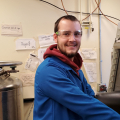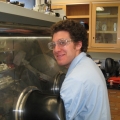
Metal Ligand Mulitple Bonds
Small molecule activation is the cornerstone or modern organometallic chemistry. It is a key to many important transformations, including olefin polymerization, C-H bond activation, ammonia synthesis, and water oxidation. We use metal ligand multiple bonds to coax small molecules (e.g., NO, CO, CO2, N2O, ethylene) into reactivity. Within this project there are two sub projects:
Actinides: Unlike the transition metals, where small molecule activation has been studied for 50+ years, uranium small molecule activation is a nascent field with many fundamental discoveries yet to be made. This represents a unique opportunity since uranium exhibits properties not found in any other element and may display reactivity different than that of the transition metals. In particular, its large ionic radius and the presence of both d and f orbitals suggest the possibility of designing unprecedented catalytic transformations. Our research program intends to fully realize the promise of uranium by closing the gaps in our understanding of this element. Recently we developed a new route to the formation of terminal chalcogenides via cleavage of a trityl protecting group. We are now investigating the coordination chemistry and reactivity of these complexes to better understand the nature of U=E bonds (E = O, S, Se, Te). We also collaborate with several other research groups to investigate these complexes computationally.
Transition metals: Our research on the synthesis transition metal ligand multiple bonds is focused on the late transition metals (groups 9, 10, and 11). Such complexes are rare and can exhibit interesting reactivity including CH bond and small molecule activation. Application of a reductive deprotection strategy, developed in our lab, has led to the isolation of the first masked terminal nickel sulfide. The sulfide ligand in the complex has been found to activate biologically important small molecules, such as N2O.
Publications
- Synthesis of a "Masked" Terminal Nickel(II) Sulfide by Reductive Deprotection and its Reaction with Nitrous Oxide
- Thorium-ligand multiple bonds via reductive deprotection of a trityl group
- Reversible chalcogen-atom transfer to a terminal uranium sulfide
- Synthesis of uranium-ligand multiple bonds by cleavage of a trityl protecting group








